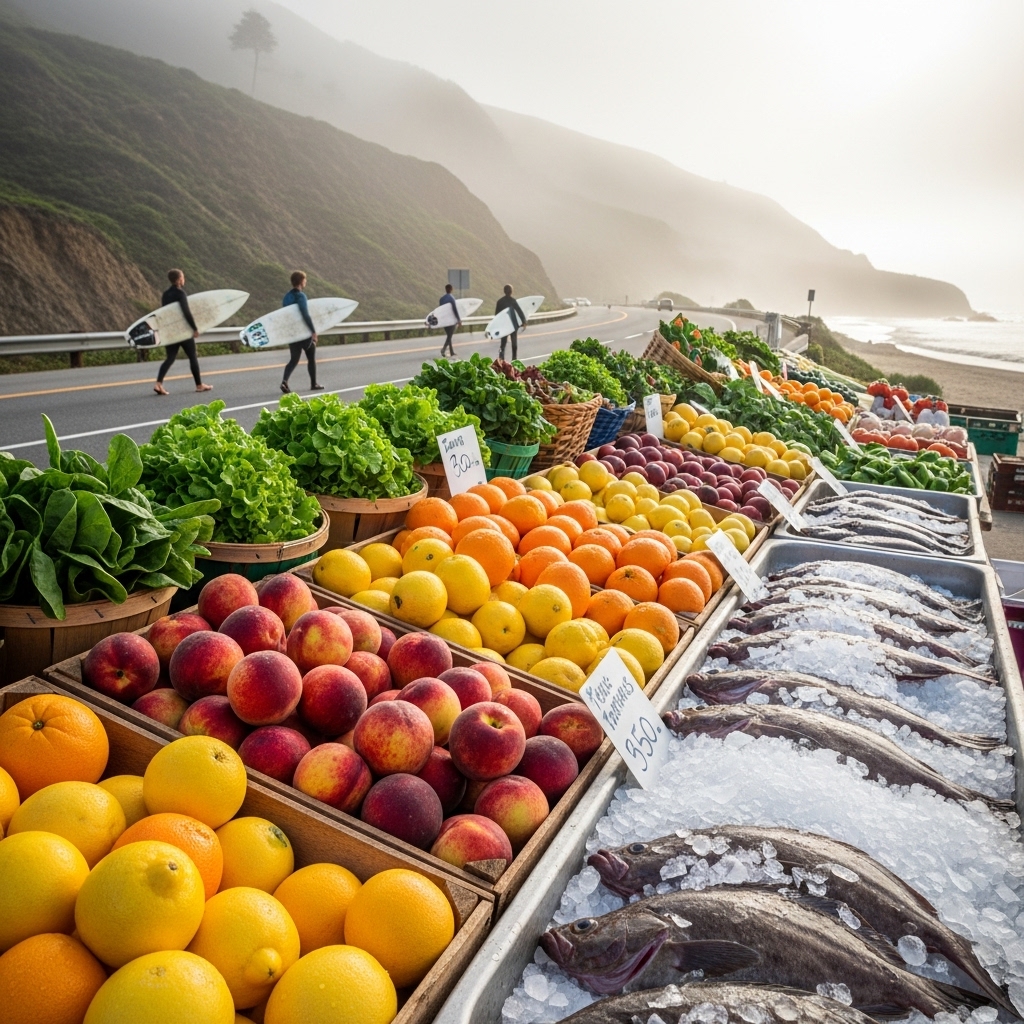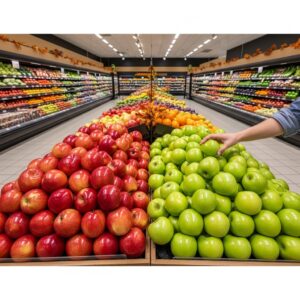Morning in Malibu has a rhythm all its own. The marine layer slips over the canyons like a cotton shawl, surfers tow boards across the sand at first light, and along the Pacific Coast Highway the chatter of neighbors rises around crates of stone fruit, baskets of greens, and iced tubs of just-landed fish. If you time it right, you can watch the sun burn through the fog as you taste the first slice of a perfectly ripe peach or the briny snap of seaweed salad prepared by a local vendor who knows exactly which cove yielded the day’s harvest. For anyone curious about how to plan a market-inspired menu, a quick peek at the weekly deals can spark ideas while you sip coffee and decide which stalls to visit first.
Living here, I’ve learned that a market is more than a place to buy ingredients; it’s a living map of our coastal terroir. The stalls tell a story of hillsides terraced with citrus and avocados, of creek-fed fields where lettuces stay tender even after a Santa Ana blows through, and of kelp forests offshore that cradle halibut and rockfish. On clear days you can smell the ocean in the air as oysters rattle in mesh bags and fishermen tell you where they set their traps, pointing toward Point Dume or past Trancas where the swells break in curling glass.
From Canyon Farms to Coastal Flats
The backbone of Malibu’s fresh market scene is a constellation of family farms spread from the Oxnard Plain to the sheltered pockets of the Santa Monica Mountains. Producers arrive with dirt still under their nails, bragging, in the gentlest way, about the snap of their sugar snap peas or the buttery interior of their Hass avocados. Because our region straddles ocean breezes and inland heat, you’ll often see cool-weather greens like little gem lettuce sitting alongside sun-loving tomatoes earlier than you might expect. Farmers will explain how the marine layer keeps nights cool, allowing delicate crops to retain sweetness and crunch.
Walk a little farther and you might hear the soft rustle of corn husks. Some seasons, the ears are small and intensely sweet, the result of dry conditions that concentrated flavor. In wetter years, the ears grow bigger and juicier, perfect for a quick char over hardwood or a toss with lime, cilantro, and a sprinkle of sea salt from a local purveyor. Part of the pleasure is talking through these seasonal shifts with the people who coaxed each stalk from seed to stand.
The Seafood Tables: A Window Into the Pacific
It’s impossible to talk about local food in Malibu without lingering over the seafood tables. I like to arrive early and ask the fishmonger what’s moving—often it’s hook-and-line rockfish or halibut, glistening with silver scales and clear eyes, or spiny lobster when the season opens and the air carries that crisp snap of fall. Some mornings there are trays of uni from sea urchins cracked moments before; other days feature spot prawns still twitching under the ice. The fishermen will tell you how a swell changed the bottom structure, how the kelp canopy shifted, or how currents brought cold, nutrient-rich water to the shelf, all of which guide the day’s catch.
Good fish is as much about handling as it is about luck on the water. Many of our local vendors practice careful icing on board and short runs back to the pier, which you can taste in the clean sweetness of the flesh. They’ll talk you through filleting tips or how to poach gently so the halibut flakes like satin. When I’m cooking for friends, I’ll buy a whole fish and ask the monger to save the bones for fumet; it’s the kind of detail that turns a simple grilled fillet into a meal that tastes like Malibu looks—breezy, luminous, and just salty enough.
Pairing the Land and Sea
The joy of our market is in how easily the produce and seafood talk to each other. Fennel bulbs with feathery fronds are natural partners for grilled rockfish, the anise perfume balancing the oil-rich meat. Early summer tomatoes, still warm from the sun, collapse into a quick pan sauce with garlic, capers, and a squeeze of lemon over sautéed prawns. In winter, when citrus bouquets stack high—blood oranges, Cara Caras, and tangy kumquats—you can segment fruit into a bright relish for roast sablefish. You come to understand that seasonality isn’t a rule; it’s a rhythm, and when you follow it, your cooking feels effortless.
There’s a rhythm to shopping, too. I like to make a full loop first, tasting along the way, talking with ranchers about grass-fed cuts for a weekend asado or checking whether the egg vendor’s hens are on pasture near the canyons. After the loop, I circle back with a plan, catching the fish stand before the most coveted fillets sell out. The market hums with neighbors swapping tips—how to coax jammy texture from Santa Rosa plums, which farm’s cucumbers stay crisp in the fridge, where to find a punnet of berries that tastes like August even when fog lingers until noon.
Voices of the Market
Our vendors are storytellers as much as growers and fishers. One farmer loves to talk about soil: he rotates brassicas through beds to keep nutrients in balance, then plants cover crops to rest the field. Another vendor, a second-generation angler, tells you how his father set traps by feel in the years before GPS, reading the water by color and the breeze by temperature. Listen long enough and you’ll pick up the vocabulary of place—the sandy soils near Camarillo that nurture strawberries with a distinct perfume, the sheltered pockets near Calabasas where late frosts hide, the afternoon winds off Zuma that keep mildew at bay on trellised beans.
As these stories stack up, you build a map in your head. You know to head to the western edge of the stalls for the sweetest melon; you know which coolers hold the day’s oysters, and you can sense when the line is forming for spiny lobster. Even on weeks without a shopping list, the market itself provides direction: baskets of padrón peppers suggest a tapas night with grilled sardines, while a crate of vibrant chard whispers of a simple supper with olive oil, garlic, and lentils.
Cooking at Home With Market Finds
I keep weeknight recipes so simple they barely qualify as recipes. A favorite is halibut baked low with olive oil, lemon slices, and thyme, then finished with a quick relish of chopped green olives and diced Persian cucumber. In summer, I’ll spoon that over a salad of arugula and shaved fennel bulbs, letting the juices dress the greens. Another standby is a tomato-water broth—salted chopped tomatoes pressed through a sieve, then warmed with garlic and poured over just-poached rockfish. The broth is almost clear, delicate but insistent, and tastes like a wave catching sun.
Vegetables are stars in their own right. If you find baby squash with blossoms attached, gently stuff blossoms with ricotta and herbs, then pan-fry in the lightest coating of flour until the exterior crackles. Serve beside a heap of grilled scallions and a bowl of charred corn cut from the cob, tossed with cilantro stems for crunch. For a picnic on the beach, I pack marinated tomatoes with basil, a wedge of tangy goat cheese, and a container of seaweed salad from the seafood stand—salty, mineral, and bright.
On some mornings, before I’ve even settled on a plan, I’ll browse the weekly deals on my phone and let the ideas snowball. Seeing which fruits and vegetables are in abundance reminds me to think in color: emerald cucumbers with ruby plums, saffron-yellow squash with amethyst-hued eggplant. The fish I pair by texture—firm halibut for the grill, tender rockfish for a quick sauté, buttery black cod for a slow roast that perfumes the house.
Seasonality, Weather, and the Malibu Microclimate
Malibu’s microclimates are as much characters at the market as any vendor. In deep summer, heat pulses from canyon to coast, but the afternoon sea breeze keeps stalls comfortable. In fall, the Santa Anas arrive, dry and warm, bringing exceptionally sweet peppers and crisp-skinned apples from higher elevations. Winter is citrus poetry: bins explode with grapefruit, mandarins, and lemons, and avocados set like ornaments on the tree. Spring is a flourish of greens—frilly lettuces, herbs that smell like the garden after rain, and peas plucked so young they snap like glass.
This variability makes shopping intuitive rather than scripted. If the marine layer lingers late, I look for produce that likes cool mornings: radishes with lively heat and greens that glisten. If it’s hot early, I’ll shift to ripe tomatoes and melons, trusting they’ve concentrated sweetness under the sun. The fishers adapt too, changing gear and grounds based on conditions, which is why you’ll sometimes find one species abundant and another rare from week to week.
Community, Sustainability, and Respect for the Coast
There’s a quiet ethos that runs through the market: take what you need, celebrate what the land and sea offer, and respect the cycles. Vendors know their limits, and the best compliment you can pay is to cook with care. Many farms practice organic or low-input methods, but even those not certified carry a stewardship mindset—cover cropping, composting, efficient irrigation. Fishermen speak about size limits, seasons, and bycatch reduction as a matter of course. It’s not performative; it’s how you work if you hope to be in business ten years from now.
As locals, we return that respect by learning to cook whole fish, by choosing lesser-known cuts and species, and by celebrating imperfect produce that tastes incredible. I love the look on someone’s face the first time they grill smelt over a camp stove by the sand or roast a slightly blemished heirloom tomato that turns into pure velvet. Eating this way doesn’t just nourish; it reframes your week around moments that feel connected and calm.
Planning a Market Day
For newcomers, here’s how a typical morning flows. Park with enough time to stroll without rushing. Start with coffee, make the first loop, taste thoughtfully, and talk to the vendors whose food pulls you in. Pick your seafood early, then shop for produce to match. Keep a small cooler in the trunk with an ice pack if you plan to linger on the pier or stop at the beach. When you get home, store greens dry and loose, tomatoes on the counter, and fish on a plate wrapped in parchment with a light cover. Plan your meals so the most delicate items star first, saving sturdier vegetables for later in the week.
And always leave room in your bag for the unexpected—the bunch of basil that smells like sun-warmed fields, the tiny cucumbers that crunch like a cool wave, or the loaf of bread with a crust so resonant it sings when you tap it. A market day isn’t about perfection; it’s about finding your week’s anchor in a few beautiful ingredients.
Frequently Asked Questions
What time should I arrive for the best selection?
Arriving early gives you the widest range of both produce and seafood, and it’s when fishmongers still have whole fish and specialty cuts. If you prefer a slower pace, late morning can be pleasant, though certain items may be gone. The key is to plan a loop, decide quickly, and come with a flexible menu in mind.
How do I know if the fish is truly fresh?
Look for bright, clear eyes on whole fish, firm flesh that springs back when pressed, and a clean ocean scent. Ask the vendor about where and when the fish was caught; local sellers are proud to share details about the waters off Point Dume, Trancas, or beyond. Trust the monger who can explain handling practices and offer simple cooking suggestions.
Are there specific seasons for local seafood?
Yes. While availability shifts based on weather and ocean conditions, you can expect spiny lobster in its open season, halibut and rockfish at various points year-round, and occasional runs of spot prawns or sea urchin. Asking what’s moving that morning is the surest way to shop with the season.
How should I store produce once I’m home?
Keep leafy greens dry and in breathable containers in the refrigerator, store tomatoes on the counter out of direct sun, and refrigerate berries in a shallow layer to avoid crushing. Herbs last longest upright in a jar of water, loosely covered. Plan meals so the most perishable items are enjoyed first.
Is everything organic?
Not all vendors carry certification, but many use organic methods or minimal interventions. The best approach is to ask each producer about their practices; they’ll explain how they manage soil health, pest pressure, and water conservation. Certification is one indicator, but transparency and flavor are reliable guides.
Can I bring my dog?
Policies vary by location, and consideration for crowd flow and safety usually guides the rules. If dogs are permitted, keep them leashed and mindful of both children and food displays. When in doubt, check signage as you enter or plan to leave pets at home on busier mornings.
What if it rains or winds pick up?
Markets in Malibu adapt to weather. Light rain often means a cozier scene and fewer crowds; heavy wind can prompt some vendors to pack early. Planning your visit with a flexible window and packing a light jacket is wise, especially during shoulder seasons.
Can vendors fillet fish for me?
Many can and will, particularly if you arrive early before lines build. If you’re new to cooking whole fish, ask for a simple preparation tip along with your fillets; most mongers enjoy helping you succeed at home.
If you find yourself midway through the stalls, unsure whether to commit to uni or halibut, take a breath and look around. Talk to one more farmer, taste one more slice of peach, and check the weekly deals for a nudge toward a flavor you might have overlooked. The best meals often come from a happy accident—a bag of padróns you didn’t plan on, a handful of wild arugula that smells peppery and green.
When the sun climbs and the breeze shifts, you’ll head home with a car that smells faintly of citrus and sea. That mix doesn’t fade quickly; it lingers through the week as you cook, reminding you of easy conversations at the stalls and the salty brightness of the coast. Malibu makes it simple to eat like this, and once you start, it’s hard to imagine shopping any other way.
Ready to turn a Saturday stroll into a week of unforgettable meals grounded in our coast’s bounty? Start planning your market route, bring a cooler for the catch, and let the season lead. For menu inspiration before you go, browse the weekly deals, jot down a few pairings that excite you, and meet the people who raise, catch, and craft the flavors that define Malibu. I’ll see you by the seafood tubs, where the ice crackles and the day’s stories begin.




